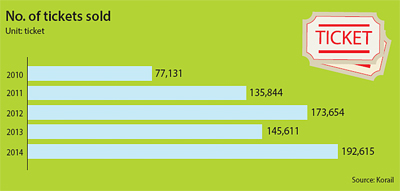Rail pass program proves too popular for Korail

Rather, Kang was boarding the train on a Rail-ro pass, along with many similarly young travelers holding passes that allow them to take free or standing seats aboard trains.
The Rail-ro program, run by the Korean Rail Corporation (Korail), allows pass holders to hop on and off trains by taking standing or free seats. The program is limited to Koreans under the age of 25, and Korail releases roughly 10,000 tickets per day.
The name Rail-ro is a portmanteau of “rail,” which is also a homophone for “future” in Korean, and “ro,” which means “path.”

During the program’s first year, the number of railers was close to 8,000. By 2014, the number surpassed 192,000.
Korail sells Rail-ro passes only twice a year, in the summer from June to September and in the winter from November to March. Five-day passes cost 56,500 won ($50) and seven-day passes go for 62,700 won. Railers are free to board most types of trains, including the ITX-Cheongchun, ITX-Saemaeul, Saemaeul, Nuriro and Mugunghwa.
To take advantage of the seasonal influx of young travelers on the Rail-ro program, local Korail affiliates are offering discounted tour packages or free travel kits.
Upon arrival at Busan Station, for example, railers can pick up a kit with a disposable sitting cushion, towel, first aid kit, tumbler and vitamin drinks.
In Jeonju, North Jeolla, travelers can take advantage of cut-rate accommodations at the local Hanok Village, and railers in Danyang County, North Chungcheong, can go paragliding at half the normal price.
Seeking respite from the rat race of daily life, Kang Yea-na went on summer rail trip in July 2014 on a Rail-ro pass.
“I wanted to escape from work and school, and try new things I have never done before,” she said. “At first, I was terrified that there was no one to rely on, but I found myself becoming more independent because I had to look for things and make decisions on my own, like what to eat and where to stay.”
Kang ran into obstacles she did not expect when riding the trains as a railer. She complained about trains arriving at one-hour intervals and said she wasted time waiting at stations for the next train after missing one. Kang would have to rearrange her plans for the entire day.
“At the end of the trip, the weather was getting hotter, and railers got more easily irritated,” she recalled. “The longer they stayed on the platform to wait for a train, the worse they felt.”
Another railer, 25-year-old Shim Gi-bum who is now an accountant in Seoul, set out on a trip in 2015. For him, it was a way to relieve the uncertainty and anxiety he felt about his future after being discharged from the military.
“After I talked to other railers on the train, I realized I was not the only person who was at a loss on what to do in life,” Shim said. “It was a relief to know they were also struggling with the problems I had.”
Shim recalls his Rail-ro experience as a life-changing opportunity for him to meet strangers his age.
“It helped me become a more sensible person,” he said. “I felt like I graduated from my early 20s and entered my late 20s through the Rail-ro trip.”
“This stamp book is like a diploma,” he said, holding up his Rail-ro pass.
Hong Yi-wha, a psychology professor at KC University, said the travel program has benefits for the psychological development of youth and provides them with relief from the stresses of modern life.
“As a solution, it seems that the Rail-ro program has better conditions than any other trip program,” the professor said. “The young can face a bumpy road by sitting in a cramped space for a long time and waiting for a train in the hot sun. According to the psychological concept of resilience, frustrating hardship and failure can turn into opportunities to leap higher.”
Shim notes that one of the most difficult parts of his trip was the lack of seats.
“The trains were too small to fit the increasing number of railers,” he said. “It turned into chaos.”
Lee Jae-young, a 26-year-old student from Seoul who traveled with his friends on a different type of rail pass for older Koreans, felt the same.
“I was going to Daegu and took the train at 11 p.m.,” he said. “There were no seats left, so I crouched in a corner of the train for four and a half hours because it was already full of railers.”
As demand for Rail-ro passes increases, crowded trains have become a common issue.
“I recognize the problems with safety and inconvenience from the deficiency of seats,” an official in the Korail publicity department said. “However, railers looking for guaranteed security and ease of travel do not fit in with the Rail-ro program. It would be better for them to buy normal tickets.”
BY SIM SO-YEON AND JIN YU-JEONG [simso269@gmail.com, jinyj5@hanmail.net]










with the Korea JoongAng Daily
To write comments, please log in to one of the accounts.
Standards Board Policy (0/250자)